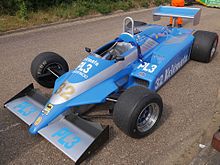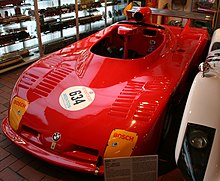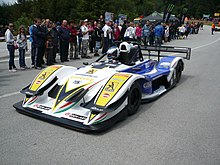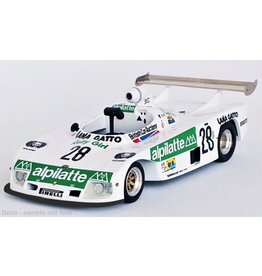OSELLA
Osella is an Italian racing car manufacturer and former Formula One team. They participated in 132 Grands Prix between 1980 and 1990. They achieved two points finishes and scored five world championship points.
Early days

Named after its founder Vincenzo "Enzo" Osella, the team began life by racing Abarth sports cars among local and national races in Italy since 1965. Though relatively successful (Osella eventually took over the factory Abarth sports car program), Osella expanded into single-seater racing in 1974 to further develop his business. In 1975, the team entered the European Formula Two Championship for the first time, achieving some success with its own car, the BMW-powered Osella FA2.

Osella continued in Formula Two in 1976, but financial problems meant that the team was not competitive and withdrew from the championship before the end of the season. In the following years, the FA2s were occasionally entered by privateers, one of them being the Swiss Charly Kiser.
Late 1970s
Enzo Osella tried to make some money by selling a self-penned Formula Three car, the Osella FA3, with little success. Only a few privateers were optimistic enough to buy the simple, untested machine, which with Toyota or Lancia engines competed in the 1976 German and Italian F3 championships without making any great impression. After this, the team concentrated on running in local sports car events during 1977 and 1978.
Osella returned to the European Formula Two Championship in 1979, with American driver Eddie Cheever racing the well-used FA2, again powered by a BMW engine. The car was good enough to win three races and take Cheever to fourth in the championship. This was enough for Enzo Osella to take the plunge into the cut-and-thrust world of Formula One.
Formula One
Early years
Osella Squadra Corse appeared in the world of Grand Prix racing with its first Formula One machine, the FA1. The car was designed by Giorgio Stirano. Powered by Ford Cosworth DFV, it was overweight and aerodynamically inefficient. The car was presented in a blue and white livery with large Denim branding on the sidepods. Many components were manufactured in-house which meant that they were cheap to produce but not always state-of-the-art. The driver was again Eddie Cheever who was able to finish just one race in the whole season. Frequently he had to suffer from the massive unreliability of his car. In the following seasons, the basic design was changed several times.
In the early years, most of the work was done by interim designers like Giorgio Valentini or Tony Southgate, but frequently Enzo Osella himself also worked on the cars. Most of these attempts brought no improvement as high-tech solutions could not be financed. Jean-Pierre Jarier finished fourth at Imola in 1982 (where only 14 cars started) and scored the first Championship points for the young team in a car that was by now dubbed Osella FA1C.
Despite this result, neither the financial nor the technical situation improved. Few sponsors were attracted by the tiny Italian team. Denim only stayed for the first two seasons, Kelemata was no more reliable, and others like Landis & Gyr vanished as quickly as they had come. Most of the other sponsors were small or mid-size companies from Turin or the region of Piedmont.
Driver changes

The lack of funding led to frequent driver changes as the team demanded that their drivers bring significant sponsorship to keep the team afloat. Some drivers started their F1 careers at Osella, such as Alex Caffi and Gabriele Tarquini, while Piercarlo Ghinzani had four stints with the team. Others disappeared as quickly as they had come, such as Allen Berg and Franco Forini. Enzo Osella gave the young Austrian Jo Gartner his one and only chance to drive a Formula One car in 1984. Riccardo Paletti also had high hopes, but was killed in a start-line accident at the 1982 Canadian Grand Prix.
None of these drivers were able to push the team forward. Finally, Osella continued to live hand-to-mouth each year, with little or no improvement in competitiveness.
Alfa Romeo

In the mid-1980s, Osella was the beneficiary of factory Alfa Romeo engines, both in naturally-aspirated (1983–84) and turbo (1984–88) forms. On one hand, the Alfa engine program helped the team to survive the increasingly professional turbo era; on the other hand, the heavy, unreliable and thirsty machines contributed to the team's lack of competitiveness. At least at first, Alfa offered some technical input to the team; the 1984 Osella FA1F was based on the 1983 works Alfa Romeo 183T, which had been loaned to the team for "design assistance" purposes. All the following Osella models up to the FA1L in 1988 had their origins in the initial Alfa design.
The Alfa turbo engine, the 890T, was not reliable. Turbos blew up regularly and power output had to be reduced down to the level of the non-turbo cars just to achieve the necessary reliability. On more than one occasion, Osella tried to replace the 890T with more up-to-date Motori Moderni turbos (which Minardi did not support) or with Cosworth engines. In the end, both were too expensive, so Osella had to stick with the increasingly outdated but cheap 890T.
For 1988 – the last year before turbos were banned – the team re-branded the 890T as the "Osella V8". This came about after Alfa's parent company, Fiat, grew tired of the negative publicity the team had given the 890T and, while allowing them to continue using the engine, refused to allow the Alfa Romeo name to be used.
After driver Nicola Larini managed some impressive times in pre-season testing at Monza, the team were quietly confident of a decent showing through 1988, as many teams had switched to naturally-aspirated engines in preparation for 1989. However, the reality was that the FA1L, with its outdated turbo, was not up to the challenge: Larini often failed to qualify or even pre-qualify, and was also excluded from the San Marino Grand Prix before practice after failing to get through scrutineering due to illegal changes made to the chassis. At the end of the season, Enzo Osella was more than happy to be finally rid of the old Alfa engine.
Cosworth power and Fondmetal
The 1989 season saw much improvement. The all-new, Cosworth DFR-powered Osella FA1M was a big step ahead, and ultra-sticky qualifying tyres from Pirelli brought some success, at least in the qualifying sessions (most notably in the Japanese Grand Prix, where Larini qualified 10th). The fine qualifying performance brought no results in the races; the Osella cars almost never saw the finish line due to several technical failures. The most tragic race was the Canadian Grand Prix in which Larini was third before the FA1M's electrics failed due to water ingress. Piercarlo Ghinzani re-joined the team for 1989 with limited success, often failing to qualify. He announced his retirement at the season ending Australian Grand Prix. While Larini failed to start the very wet race when his electrics were water-logged on the grid, Ghinzani's race and career came to a violent end when a high-speed collision with the Lotus of Nelson Piquet left Ghinzani with an injured ankle.
In 1990, after ten years in Formula One and still without any meaningful sponsorship, Enzo Osella sold shares in his team to metalwork magnate Gabriele Rumi, as part of a sponsorship deal with Rumi's Fondmetal company. During 1990, the team entered a single car for French driver Olivier Grouillard, who gained a reputation in F1 for being a "blocker", holding up faster cars and ignoring his mirrors. At the end of 1990, Rumi took over the remainder of the team and renamed it Fondmetal.
Sportscars
The involvement of Gabriele Rumi meant the end of Enzo Osella's activities in Formula One. Instead he concentrated on the thing he knew best: sports car racing. During his Formula One years, he never gave up building sports cars; in fact this was one of the few projects that regularly brought work and money to Volpiano, especially in hillclimb races, with Mauro Nesti many times winner of European and Italian Championship, and many other drivers, with PA9 and PA9/90 models.
A few of those sports cars even found their way to the Can Am series, although without much success. The most prestigious result was during the 1984 Can Am season with a third place in the championship for the 2-litre class; the car was the Osella PA10 driven by Armando Trentini, and was the only two-seater in the championship; the rest of the 2-litre class field comprised single-seater F2 cars with covered wheels.
In the 1990s, Osella moved to Atella in the south of Italy where he built a new ultra-modern facility to produce some very competitive sports cars. Many of them were sold to privateers, while others were entered in several classes by the Osella works team. The works team was particularly successful in hillclimb races. In 1995 for instance works team driver Pasquale Irlando won all 9 races of the European hillclimb championship using the Osella PA20. He won the title in 1997, 1998 and 1999 consecutively. His successor Fabio Danti died in one of Osella's cars when he was competing in the 2000 Championship. Hillclimb stars like Franz Tschager and Martin Krisam continue to use Osella cars.The factory was transferred back near Turin, in Verolengo and continue activity building sport cars for hill climbing and minor sport race championship.
At the end of 2022, Osella Motorsports LTD has acquired Osella Engineering , which will see the longtime Italian prototype constructor be aligned under Enzo Osella and Giuseppe Angiulli, the heart of the company. The company, to be known as Osella corse, will continue to produce The range currently being manufactured such, the “small” PA21 JrB from the E2B class, that can be equipped with motorcycling propellers from 1000 to 1600 cc., with a set-up both for hill climbing and track. We then arrive to the multi-titled Pa21 Evo CN2 motorised with the Honda 2 liters, a car at the Top of the class for years both in the track and hill climbing versions thanks to the continuous updates. Still among the 2 liters, but with the surprising PA 2000 (E2B) motorised with the maximum evolution of the 2000cc. 4 cylinders Honda Barchetta which has a very sophisticated aerodynamics and can count on a very reduced weight allowing it to compete with the most powerful 3000 cc.For those still not being pleased enough, are available Pa30 and FA30, respectively two-seater and single-seater of the 3000 class. According to the availability of the propeller from the client, it is possible to set it up with the V8 Zytek or in the Evo version with the V8 RPE, cars as well as pursue “new challenging projects” and international development of the brand, like the new Osella Stradale,which is currently on development. “This new collaboration will breathe life into Osella and also into the spirit that has been driving us,” said Osella founder Enzo Osella.
- AB VOLVO
- AC CARS
- ACADIAN
- ACURA
- ADLER
- AEC
- ALFA ROMEO
- ALFA ROMEO BY ABARTH
- ALFA ROMEO BY BERTONE
- ALFA ROMEO BY CARROZZERIA TOURING
- ALFA ROMEO BY CASTAGNA
- ALFA ROMEO BY COLLI CAROZZERIA
- ALFA ROMEO BY GHIA
- ALFA ROMEO By ITALDESIGN
- ALFA ROMEO by OSI
- ALFA ROMEO by PININFARINA
- ALFA ROMEO BY TOURING
- ALFA ROMEO by VIGNALE
- ALFA ROMEO BY ZAGATO
- ALLARD MOTOR COMPANY LIMITED
- ALPINE(SOCIETE DESAUTOMOBILES ALPINE SAS)
- ALVIS
- ALVIS BY VANDEN PLAS
- AMC(American Motor Company)
- AMILCAR
- AMILCAR by LA PHOCEENNE
- APRILIA
- Argo Racing Cars Ltd.
- ARMSTRONG WITHWORTH AIRPLANE COMPANY
- ART & TECH STUDIO
- ASA (Autocostruzioni Società per Azioni)
- ASTON MARTIN
- ASTON MARTIN by BERTONE
- ASTON MARTIN by BONIOLO
- ASTON MARTIN BY GRABER
- ASTON MARTIN by ITALDESIGN
- ASTON MARTIN by OGLE
- ASTON MARTIN BY VIGNALE
- ASTON MARTIN by ZAGATO
- ASTON MARTIN LAGONDA BY VIGNALE
- ASTON MARTIN LAGONDA LIMITED
- ATELIER DE CONSTRUCTION ROANNE
- ATKINSON VEHICLES LIMITED
- AUBURN AUTOMOBILE COMPANY
- AUBURN BY BEUHRIG
- AUDI
- AUDI BY DARWINPRO
- AUDI by PININFARINA
- AUSTIN MOTOR COMPANY Ltd.
- AUSTRO-DAIMLER
- AUSTRO-DAIMLER by KEIBL
- AUTOBIANCHI
- AUTOBIANCHI BY BERTONE
- AUTOBIANCHI BY PININFARINA
- AUTOBIANCHI BY ZAGATO
- AUTOMOBILI LAMBORGHINI S.p.A.
- AUTOMOBILI LAMBORGHINI SpA by CHRYSLER
- AUTOMOBILI LAMBORGHINI BY LB WORKS
- AUTO UNION
- AVIA MOTORS S.R.O.
- AVRO
- AvtoKuban
- BAE Systems AB
- BAJAJ
- BARKAS(VEB Barkas-Werke)
- BARREIROS DIESEL S.A.
- BAUER CARROSSERIE
- BEDFORD
- BelAZ
- BELL
- BENELLI
- BENTLEY
- BENTLEY by FRANAY
- BENTLEY by GRABER
- BENTLEY by MULLINER
- BENTLEY BY PININFARINA
- BENTLEY BY WENDLER
- BERLIET
- BERTONE
- BETA MOTORCYCLES
- BMC(The British Motor Corporation LTD)
- BMW
- BMW BY ALPINA
- BMW by Bertone
- BMW by DarwinPRO
- BMW by FRUA
- BMW by ITALDESIGN
- BMW BY LIBERTY WORKS
- BMW by PININFARINA
- BMW by ZAGATO
- BORGWARD
- BRISTOL CARS LIMITED
- BRITISH LEYLAND
- BRM(British Racing Motors)
- BUGATTI
- BUGATTI BY BERTELLI
- BUGATTI by VANDENPLAS
- BÜHRER TRAKTORENFABRIK AG.
- BUICK
- BUICK BY LANCEFIELD
- BUICK by PININFARINA
- BÜSSING AG
- CADILLAC(GENERAL MOTORS)
- Cadillac by ASC
- Cadillac by Derham.
- CADILLAC by EUREKA & Co.
- Cadillac by Fleetwood
- CADILLAC BY MILLER-METEOR
- CADILLAC BY PININFARINA
- CAGIVA
- CANADIAN MILITARY PATTERN(CHEVROLET)
- CATERHAM CARS
- CATERPILLAR
- CHECKER MOTORS CORPORATION
- CHEVROLET
- CHEVROLET BY AMERICAN CUSTOM COACHWORKS.
- Chevrolet by Bertone
- CHEVROLET by PININFARINA
- CHEVRON CARS
- CHRYSLER
- CHRYSLER BY GHIA
- ChTZ(Chelyabinsk Tractor Plant)
- CIMATTI
- CISITALIA by PININ FARINA
- CISITALIA BY PININFARINA OR VIGNALE
- CISITALIA by STABILIMENTI FARINA
- Citroën
- CITROËN by BERTONE
- Citroën by H.Chapron
- CITROËN by PININFARINA
- CIZETA-MORODOR
- COMMER
- CONDOR-WERKE AG
- CORD
- CORD BY HAYES BODY COMPANY
- COURAGE COMPETITION
- CROSLEY CORPORATION
- DACIA
- DAF
- DAIHATSU MOTOR Co.Ltd.
- DAIMLER(D)
- DAIMLER(UK)
- DAIMLER BY WILCOX
- Dallara Group S.r.l.
- DATSUN
- DB PANHARD
- DE HAVILLAND
- DE HAVILLAND BY MORRIS MOTOR COMPANY
- DELAGE(SAFAD)
- DELAGE BY AUTOBINEAU
- DELAGE by H.CHAPRON
- DELAGE FERNANDEZ & DARRIN
- DELAGE BY LETOURNEUR & MARCHAND
- DELAGE by PARTOUT
- DELAHAYE
- DELAHAYE BY CHAPRON
- DELAHAYE BY FIGONI & FALASCHI
- DELAHAYE BY GILLORE
- DELPHI INDY CAR
- Demm Motorcycles (Spa Officine Meccaniche Fratelli Daldi & Matteucci, Porretta Terme)
- Dennis Brothers LTD
- DENZEL AUTOMOBILE COMPANY
- DESOTO(CHRYSLER)
- DE TOMASO
- DE TOMASO by GHIA
- DE TOMASO by FISSORE
- DEUTSCH-BONNET(Panhard engine)
- DEUTZ-FAHR
- DEVON MOTORWORKS
- DIAMOND T
- DIFFERENT CAR MODELS
- DISNEY
- DKW
- DODGE(CHRYSLER)
- DODGE BY GHIA
- DOME Co.LTD
- DONKERVOORT AUTOMOBIELEN BV
- Dr.-Ing.Ulrich ESTERER GmbH & Co.KG.png
- DUCATI MOTOR COMPANY S.p.A.
- DUCKHAMS COSWORTH
- DUESENBERG
- DUESENBERG BY BOHMAN & SCHWARTZ
- DUESENBERG BY D'IETEREN
- DUESENBERG BY FIGONI
- DUESENBERG BY G.NUTTING
- DUESENBERG BY LAGRANDE
- DUESENBERG BY MURPHY
- DUESENBERG BY ROLLSON/ROLLSTON
- DUPLE COACHBUILDERS
- DV BUS & COACH
- DZERZHINSKY PLANT KIEV
- EBRO
- EDONIS
- EDSEL
- Eidgenössische Konstruktionswerkstätte
- EMW(Eisenacher Motorenwerk)
- ENFIELD
- ERF
- ERICH BITTER AUTOMODELS GmbH(BITTER)
- EUROCOPTER GROUP
- Fábrica de Automotores Utilitarios SAICF
- FACEL S.A.
- FBW(Franz Brozincevic Wetzikon)
- FENDT
- FERRARI S.p.A.
- FERRARI BY BERTONE
- FERRARI by CASTAGNA
- FERRARI BY GHIA
- FERRARI BY DROGO CARROZZERIA SPORTS CAR
- FERRARI BY MICHELOTTI
- FERRARI by MODENA DESIGN
- FERRARI BY PININFARINA
- FERRARI BY SCAGLIETTI
- FERRARI BY TOURING
- FERRARI BY VIGNALE
- FERRARI BY ZAGATO
- FFA(Flug-und Fahrzeug Werke Altenrhein)
- FIAT
- FIAT BY ABARTH
- FIAT BY BERTONE
- FIAT by CAPRERA
- FIAT BY CARROZZERIA ALFREDO VIGNALE
- FIAT by CORIASCO
- FIAT by ITALDESIGN
- FIAT BY LOMBARDI
- FIAT by PININFARINA
- FIAT BY ZAGATO
- FMC(Food Machinery Corporation)
- FODEN
- FORD BY COSWORTH
- FORD BY CRAYFORD
- FORD BY LOTUS
- FORD BY SHELBY
- FORD by ZAGATO
- FORD EUROPA
- FORDSON BY FORD MOTOR COMPANY
- FORD U.S.A.
- FORD by BERTONE
- FRAZER-NASH by GIUGIARO
- FREIGHTLINER(Daimler truck North America)
- FSO WARSZAWA
- GARELLI
- GAZ(Gorky Automobile Plant)
- GENERAL MOTORS
- GINETTA-FORD
- GMC
- GOGGOMOBIL/HANS GLAS GmbH
- GRIFFITH MOTOR COMPANY
- Haas/Ferrari F1 Team
- HARLAND & WOLF
- HANOMAG
- HARLEY DAVIDSON
- HENDRICK MOTORSPORTS-NASCAR
- HEINKEL
- HENSCHEL & SON
- HHA(Hawker Hunter Aviation Ltd)
- HILLMAN BY ZAGATO
- HILLMAN MOTOR COMPANY
- HISPANO-SUIZA
- HISPANO-SUIZA BY FERNANDEZ & DARRIN
- HOLDEN(GENERAL MOTORS)
- HONDA by PININFARINA
- HONDA GIKEN KOGYO KABUSHIKI
- HYMER CAMPERS
- HOMMELL
- HORCH
- HOTCHKISS ET CIE
- HRG ENGENIERING COMPANY
- HUDSON MOTOR CAR COMPANY
- HUMBER LIMITED
- HUMMER
- HÜRLIMANN
- HYUNDAI MOTOR COMPANY
- IAME(Industrias y Mecanicas del Estado IAME)
- IKARUS
- IMPERIAL(Chrysler)
- IMPERIAL(Crysler) BY GHIA
- IMPERIAL(Chrysler)BY LE BARON
- INNOCENTI
- INNOCENTI-LAMBRETTA
- INTERNATIONAL HARVESTER
- INVICTA BY CHARLESWORTH
- INVICTA BY TOURER
- ISO AUTOMOTOVEICOLA S.p.A.
- ISOBLOC
- ISOTTA FRASCHINI & Co
- ISOTTA FRACHINI by CASTAGNA
- ISOTTA FRASCHINI BY ZAGATO
- ITALJET
- IVECO
- ISUZU MOTORS Ltd
- JAGUAR
- JAGUAR BY BERTONE
- JAGUAR by FRUA
- JAGUAR BY GRABER
- JAGUAR BY VANDEN PLAS
- JAGUAR BY VICARAGE
- JEEP(FIAT CHRYSLER AUTOMOBILES)
- JENSEN MOTORS
- JLC
- JOE GIBBS RACING-NASCAR
- JUNKERS
- KAELBLE
- KAISER JEEP
- KAMAZ
- KAWASAKI
- KAZ(Kutaisi Auto Mechanical Plant)
- KENWORTH
- KhTZ(Karkivski Tractorni Zavod)
- KIEV ELECTRIC TRANSPORTATION PLANT
- KIROV ZAVOD
- KMZ(Kragnorsky Mechanical Works)
- KOENIGSEGG
- KÖPFLI
- KRAUSS MAFFEI
- KrAZ
- Gebakken. Krupp Motoren- und Kraftwagenfabriken GmbH
- KURGANMASHZAVOD
- LADA(AvtoVAZ)
- LAMBORGHINI by BERTONE
- LAMBORGHINI by ITALDESIGN
- LAMBORGHINI by PININFARINA
- LAMBORGHINI by STROSEK DESIGN GmbH & Co.KG
- LAMBORGHINI by ZAGATO
- LANCIA
- LANCIA BY ABARTH
- LANCIA by BERTONE
- LANCIA BY COLLI CAROZZERIA
- LANCIA by PININFARINA
- LANCIA BY ZAGATO
- LAND ROVER BY CUTHBERTSON
- LAND ROVER BY TICKFORD
- LAND ROVER(TATA MOTORS)
- LANZ
- LEA-FRANCIS
- LEXUS
- LEYLAND MOTORS
- LIAZ(Liderecké Avtomobilové Zavody)
- LIGIER AUTOMOBILES
- LINCOLN
- LINCOLN BY CARIBOU MOTOR COMPANY
- LOLA
- LOTUS
- MACK
- MAGIRUS-DEUTZ
- MALAGUTI
- MALANCA MOTORS SpA
- MALYSHEV FACTORY
- MAN
- MANIFATURA AUTOMOBIL TORINO
- MARCH ENGINEERING
- MARCOS ENGENIERING
- MARMON MOTOR COMPANY
- MASERATI
- MASERATI by ATL
- MASERATI BY BERTONE
- MASERATI BY CARROZZERIA FANTUZZI
- MASERATI by GHIA
- MASERATI by ITALDESIGN
- MASERATI BY PIETRO FRUA
- MASERATI by PININFARINA
- MASERATI by TOURING
- MASERATI BY ZAGATO
- MATRA
- MATRA SIMCA
- MAVERICK MOTORS
- MAYBACH(DAIMLER-BENZ)
- MAYBACH BY WAGNER-SPOHN
- MAZ(MINSK AUTOMOBILE PLANT)
- MAZDA by BERTONE
- MAZDA MOTOR CORPORATION
- MAZZANTI AUTOMOBILI
- McDonnell Douglas
- MCI(MOTOR COACH INDUSTRIES INTERNATIONAL INC.)
- McLAREN
- McLAREN HONDA F1 TEAM
- MEGATECH
- MELKUS
- MEMMINGER
- MENARDS RACING-NASCAR
- MENGERS Special Cars GmbH
- MERCEDES AMG PETRONAS F1 TEAM
- MERCEDES-BENZ
- MERCEDES BY AMG
- MERCEDES-BENZ AMG BY DARWINPRO
- MERCEDES BY ARMBRUSTER
- MERCEDES-BENZ BY CORSICA
- MERCEDES BY CRAYFORD.
- MERCEDES-BENZ BY GLÄSER KAROSSERIE
- MERCEDES-BENZ by MURPHY
- MERCEDES BY SAOUTCHIC
- MERCEDES BY WILCOX
- MERCURY(FORD MOTOR COMPANY)
- MESSERSCHMITT
- METAL MECANICA S.A.
- MEYERS MANX(VW engine)
- MINERVA by SAOUTCHIK
- MINERVA by VAN DEN PLAS
- MINI BY BMW
- MINI by RADFORD
- MG(SIAC)
- MG BY BERTONE
- MITSUBISHI MOTORS CORPORATION
- MONTESA-HONDA
- MONTEVERDI
- MORANE-SAULNIER
- MORGAN MOTOR COMPANY
- MORGAN OLSEN
- MORETTI MOTOR Co.
- MORRIS
- MORRIS BY ZAGATO
- MOTOBECANE
- MOTOBI
- MOTO GILERA S.p.A.
- MOTO GUZZI
- MOTOM
- MOTO MORINI
- MOTOR HOLDINGS
- MV AUGUSTA
- MZMA(Moskwitch)
- NAMI(Automotive Institute)
- NASH MOTOR COMPANY
- NAVISTAR INTERNATIONAL
- NEGRINI
- NEOPLAN
- NISSAN BY LIBERTY WALK
- NISSAN BY PANDEM
- NISSAN MOTORS
- NISSAN MOTORSPORT INTERNATIONAL Co.Ltd.
- NISSAN NISMO RACING TEAM
- NOBLA AUTOMOTIVE Ltd
- North American Aviation (NAA)
- Norton Motorcycle Company
- NSU
- OLDSMOBILE(GENERAL MOTORS)
- OM(Officine Meccaniche)
- Omohundro
- OPEL
- OPEL by BERTONE
- ORECA (Organisation Exploitation Compétition Automobiles)
- OSCA
- OSCA BY FISSORE
- OSCA by ZAGATO
- OSCAR MOTOR CYCLES
- OSELLA
- PACKARD
- PACKARD BY ABARTH
- PAGANI AUTOMOBILI S.p.A.
- PANHARD
- PANOZ
- PAZ(Pavlovo Bus Company)
- PEERLESS CARS Ltd.
- PEGASO
- PEGASO BY SAOUTCHIC
- PERIPOLI
- PETERBILT
- PEUGEOT
- PEUGEOT by PININFARINA
- PIAGGIO & C.SpA
- PIERCE ARROW
- PILATUS AIRCRAFT Ltd
- PLYMOUTH
- PONTIAC(GENERAL MOTORS)
- PORSCHE
- PORSCHE by BERTONE
- Porsche by Gemballa
- PORSCHE by PININFARINA
- PORSCHE BY RWB
- PORSCHE by TOP CAR DESIGN
- PORSCHE by ZAGATO
- PP SAUBER A.G.
- PRAGA
- PROTON HOLDINGS BERHAD
- PTMF
- PUBLIC/GILLET
- RAMBLER
- RAMSES AUTOMOBILES(NSU)
- RANGE ROVER BY HAMANN
- RAPID HOLDING Ltd
- R/C(RADIO CONTROL MODELS)
- RED BULL RACING
- RELIANT MOTORS
- RENAULT
- RENAULT BY GORDINI
- RENAULT SAMSUNG MOTORS
- REYNARD MOTORSPORT(Chrysler engine).
- RIGA CARRIAGE WORKS
- RIZATTA & C S.P.A
- ROCHET-SCHNEIDER
- ROLLS-ROYCE
- ROLLS-ROYCE BY BREWSTER & Co.
- ROLLS-ROYCE BY GHIA
- ROLLS-ROYCE BY HOOPER & Co.
- ROLLS ROYCE by LABOURDETTE
- ROLLS-ROYCE BY PARK WARD
- ROLLS-ROYCE BY PININFARINA
- ROLLS-ROYCE BY WILLOUGHBY
- ROMEO-MOTRON
- ROSENGART
- ROVER BY ZAGATO
- ROYAL AIRCRAFT ESTABLISHMENT(RAE)
- RUAG HOLDING Ltd
- RVR(Rigas Vagonbuves Rupnica)
- SAAB
- SAAB by BERTONE
- SAAB BY SIXTEN SASON
- SA MINERVA MOTORS
- SANTANA MOTOR
- SAURER UND BERNA
- SAVA(AUSTIN)
- SAVIEM
- SCANIA(VW AG)
- SCAMMEL LORRIES Ltd
- SCHLÜTER
- SCIMITAR BY BROOKS STEVENS
- Scuderia AlphaTauri
- SEAGRAVE FIRE APPARATUS
- SEAT BY ABARTH
- SETRA
- SHASTA TRAILER
- SHELBY
- SIATA(FIAT ENGINE)
- SIDES
- SIMCA
- SINGER VEHICLE DESIGN
- SMEAL-SPARTAN
- SOLEX
- SPADA VETTURE SPORT
- SPICE ENGINEERING
- SPYKER CARS
- SKODA AUTO
- SLOT CARS
- SLOT CAR FERRARI
- SMART
- SSC NORTH AMERICA
- STANGUELLINI
- STEYR-DAIMLER-PUCH
- STEYR WERKE AG
- SOCIEDAD ESPAGNOLA DE AUTOMOVICES DE TURISMO(SEAT).
- STUDEBAKER BROTHERS MANUFACTURING COMPANY.
- STUTZ
- STUTZ BY LANCEFIELD
- STUTZ BY OFFICINE PADANE S.p.A
- SUBARU
- SUD AVIATION
- SUNBEAM
- SUZUKI MOTOR CORPORATION
- SVARZ PLANT
- TALBOT
- TALBOT-LAGO BY SAOUTCHIC
- TATRA
- TEAM PENSKE-NASCAR
- TEODORE CARNIELLI & C.
- TERAM (Talleres Especializados Reparaciones Autos y Motores)
- TESLA,Inc.
- TESTI MOTOR
- THE BILL TOMAS CHEETAH
- THE LISTER MOTOR COMPANY Ltd.
- THE LONDON TAXI COMPANY
- THORNYCROFT
- TOEBEHOREN
- TOYOTA BY ARCTIC TRUCK
- TOYOTA by DarwinPRO
- TOYOTA BY THE FJ COMPANY
- TOYOTA BY JMACX
- TOYOTA GAZOO RACING
- TOYOTA MOTOR CORPORATION
- TRABANT(VEB Sachsenring Automobilwerk)
- TRIUMPH STANDART MOTOR COMPANY
- TRIDENTS CARS Ltd
- TROLZA(ZiU)
- TUCKER CORPORATION
- TVR
- TVR BY FISSORE
- Tyrrell Racing Organisation
- UAZ(YA3)
- UDI(United Defense Industries)
- UKVZ
- UNIC
- URAL AUTOMOTIVE PLANT
- VAM(Vehiculos Automotores Mexicanos)
- VAN HOOL
- VAUXHALL MOTORS
- VENTURI
- VERITAS AUTOMOBILE
- VESPA/PIAGGIO & Co S.p.A.
- VEVEY
- VgTZ
- VICKERS SUPERMARINE(AIRCRAFT)COMPANY LTD
- VOLKSWAGEN
- VOLKSWAGEN BY D'Ieteren
- VOLVO CAR CORPORATION
- VOLVO TRUCKS
- Wanderer-DKW
- WARTBURG(VEB Automobilwerk Eisenach)
- WESTERN STAR TRUCK SALES Inc.
- WILLYS JEEP
- WINNEBAGO TRAILER
- W MOTORS
- WOLSELEY MOTORS LIMITED
- YAMAHA MOTOR Co,.Ltd
- YaMZ(Yaroslavl Motor Plant)
- ZELENSIS
- ZiL
- ZIS
- ZÜNDAPP
- ZWEEFVLIEGTUIGEN(gliders)





